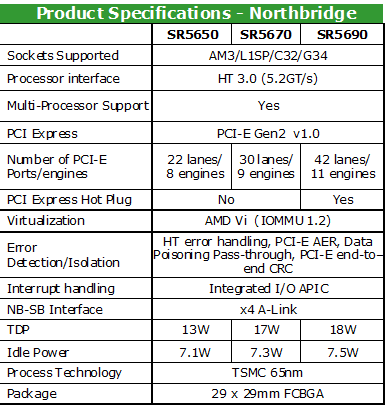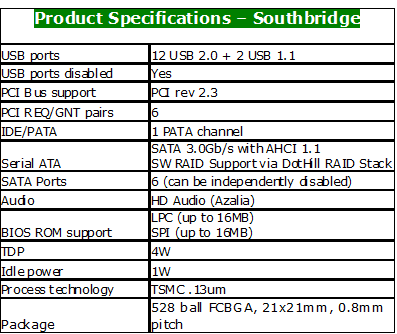AMD's 2010/2011 Roadmap from the IT Professional’s Perspective
by Johan De Gelas on November 23, 2009 12:00 AM EST- Posted in
- IT Computing
At its recent financial analyst day, AMD disclosed processor and platform roadmaps for 2010 and 2011. As the target public consisted mainly of financial analysts, the presentations focused more on AMD’s strategy and competitiveness than on technical accuracy. We had a conference call with John Fruehe and Phil Hughes of AMD and we tried to find out what the new server CPU roadmap means for our readers, the IT professionals who actually configure and buy these servers.
Compared to the mobile and desktop market, AMD is doing relatively well in the server and HPC market. The early delivery of the six-core Opteron (codenamed Istanbul) enabled Cray to build the fastest supercomputer in the world (at least for Q4 2009). It's called the the Cray XT5-HE “Jaguar” with 224162 cores, good for almost 1.76 million GFlops. The Opteron EE made heads turn in the low power cloud computing market, and the six-core Opteron is a good price/performance alternative in the rest of the server world. And last but not least, the 4-socket 84xx Opterons are the unchallenged champions in the quad socket world.
Nevertheless, AMD’s position in the server and HPC market is seriously threatened. An impressive 95 out of the top 500 supercomputers contain Intel's "Nehalem-EP" Xeon 5500 processors. Intel’s star has been rising fast in the HPC market since the introduction of the Intel Xeon 5500. Intel’s Nehalem EX is almost ready to attack the quad socket market. And there's more.
AMD created a very “cool” niche market with the 40W ACP (60W TDP) Opteron EE. Large power limited datacenters bought these CPUs in quantities of a few (and more!) thousands at once. Just a few months ago, Intel also introduced a 45 Watt Xeon L3426 at 1.86 GHz based on their Lynfield core (LGA1156 socket). Considering that AMD’s ACP numbers are rather optimistic and Intel’s TDPs are rather pessimistic, the 8-thread quadcore 1.86 GHz L3426 ($284) makes the six-core 1.8 GHz Opteron 2419EE look expensive ($989). The former can push it’s clock up to 3.2 GHz under single threaded loads, and is thus a really interesting option if your application has a significant part of non-parallel code.
So far AMD has countered Intel’s higher “per core” performance with 50% more cores. Indeed, the six-core Opteron can keep up with the Xeon 5500 in quite a few applications. But Intel is readying a slightly improved six-core version of the Xeon 5500 series called Westmere-EP in the first half of 2010. Being a 32 nm high-K dielectric CPU, the six-core Westmere-EP wil offer about the same power consumption with six-cores under load as the quadcore Xeon 5500 (Nehalem EP). At idle, Westmere-EP will consume less (14 to 22% less leakage). Westmere-EP’s architecture is identical to that of the Nehalem EP, with the exception of a 50% larger L3 cache (12 instead of 8 MB) and support for special AES instructions.
AMD's Answer
It was hardly noticeable but AMD made a historic step forward in September 2009 with the introduction of it’s own server chipsets. For the first time, AMD is a real server platform supplier, in control of both the CPU and chipset. The previous AMD server platform was mostly based on NVIDIA's nForce 3600 Pro. The nForce 3600 gave some system administrators quite a few headaches, especially in combination with VMware’s ESX. VMware’s ESX installed flawlessly on all Intel platforms we have tried so far, but it was unpredictable whether or not an nForce board would work with ESX. Of course, the added value of a tier one OEM is that they sort these things out and offer you a driver + hardware platform that is certified for ESX and others. So you could say that this was a non-issue for HP, SUN and Dell buyers (I have hardly seen any IBM Opteron based servers in the wild). Still, it is good to see that AMD is now completely responsible and in charge of it’s own server platform.


At the moment, the impact of the “Fiorano” or SR56xx chipsets is negligible. Most server vendors are preparing the servers based on the C32 socket and G34 socket and don’t feel like investing in the socket-F server platform which is at the end of its long road. Only Tyan and Supermicron, which focus mostly on the HPC market, offer servers based on the AMD SR5690 chipset right now.










107 Comments
View All Comments
yuhong - Tuesday, November 24, 2009 - link
"Ummm no, I have a Tyan Thunder K7 760 MP board and it supports USB (first gen) just fine"I think the poster was remembering the B1 stepping of the AMD 768 southbridge, which had a erratum that led to USB having to be disabled.
Here is the AMD 768 revision guide:
http://www.amd.com/us-en/assets/content_type/white...">http://www.amd.com/us-en/assets/content...e/white_...
spikespiegal - Tuesday, November 24, 2009 - link
[quote]You can spin it whatever way you want but AMD introduced features with that chipset that other companies like VIA and nVIDIA were too stupid to create at the time.[/quote]Which is likely to only impress who? Uli and SiS owners?
I also had a couple MP motherboards....great chips (especially when used with non MP / L5 hacked processors), but they were amatuer motherboards that were designed for enthusiasts. AMDs chipsets simply weren't in the same infrastructure class as ServerWorks and Intels dedicated workstation/server market - period.
This is really a shame because the XP processors in MP mode really but the schlock on the P4, because any adult here knows the P4 / Xeon was the most over-rated workstation/server platform - ever. However, the lack of a true workhorse MP platform cost AMD a lot of momentum which the AMD 64 badly needed.
If you want a reason Server Farm minders don't take AMD seriously, then here it is. Sorry AMD - too late.
niva - Tuesday, November 24, 2009 - link
Oh I'll agree with you that AMD made horrible mistakes with their market direction. They clearly had the know-how and the financial capability to push chipsets similar to how intel does but in their infinite wisdom chose not to and the little they did came too late.The same can be applied to the current state of affairs.
Unfortunately AMD is so far behind the race now that I doubt they can catch up and ever surpass intel again. Attempting to battle on other fronts (chipsets) where Intel is extremely well established is pretty impossible due to the funding required.
EthelMip - Monday, July 13, 2020 - link
https://coolmarina.brpost.info/go3JpaqVm9Vs1LY/tes...">[img]https://i.ytimg.com/vi/NXcoqc8p8qQ/hqdefault.jpg[/img]TESTANDO LANÇAMENTO https://coolmarina.brpost.info/go3JpaqVm9Vs1LY/tes...">de MAKE SUPER TECNOLÓGICA
Nancycanus - Tuesday, August 11, 2020 - link
https://gloom.mnpost.info/eZm5ppmyqdKfa3Y/the-most">[img]https://i.ytimg.com/vi/D3So4Pqom5E/hqdefault.jpg[/img]The https://gloom.mnpost.info/eZm5ppmyqdKfa3Y/the-most">most NASTY story on Episode
Soniadot - Friday, August 14, 2020 - link
https://fazeclan.grworld.info/d6-ppdTTnqen22k/we-l...">[img]https://i.ytimg.com/vi/DNqnpngsru4/hqdefault.jpg[/img]We https://fazeclan.grworld.info/d6-ppdTTnqen22k/we-l...">Lost A FaZe Member
LennaNex - Friday, August 14, 2020 - link
https://techfc3.plclip.info/xufBlBpH4us-smartphone...">[img]https://i.ytimg.com/vi/xufBlBpH4us/hqdefault.jpg[/img]SMARTPHONE GADGETS ALL https://techfc3.plclip.info/xufBlBpH4us-smartphone...">IN в‚№500 AVAILABLE ON AMAZON
AshleySmuch - Saturday, August 15, 2020 - link
https://thedetailgeek.nlworld.info/super-cleaning-...">[img]https://i.ytimg.com/vi/bM5usRQn30M/hqdefault.jpg[/img]Super Cleaning The NASTIEST Ford EscapeDisaster Car Detailing and EPIC https://thedetailgeek.nlworld.info/super-cleaning-...">Vehicle Transformation
KathiWem - Sunday, August 16, 2020 - link
https://werone.plclip.info/nOt_iasmoL4-%E0%A4%B8%E...">[img]https://i.ytimg.com/vi/nOt_iasmoL4/hqdefault.jpg[/img]स्कूल https://werone.plclip.info/nOt_iasmoL4-%E0%A4%B8%E...">BunkSukki DcWe Are One
Bernicesweno - Thursday, August 20, 2020 - link
https://momtasticbyshamsheera.plclip.info/NS87VnFt...">[img]https://i.ytimg.com/vi/NS87VnFt9mI/hqdefault.jpg[/img]Onam SpecialAll time favorite Kerala Banana ChipsBanana KheerBanana https://momtasticbyshamsheera.plclip.info/NS87VnFt...">Peel Thoran